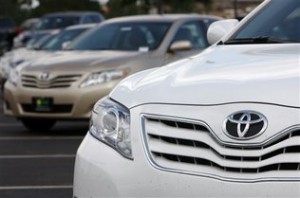Relatives of a California state trooper and three family members whose fatal car wreck helped spark Toyota’s wide-ranging safety recall have sued the automaker for defects they say caused the vehicle to speed out of control and crash.
The lawsuit, filed on Tuesday in San Diego Superior Court, was the latest in a wave of product-liability cases and other legal action brought against Toyota Motor Corp over complaints of sudden, unintended acceleration in its vehicles.
But the fiery August 28 crash near San Diego of a Lexus ES 350 sedan driven by off-duty California Highway Patrol Officer Mark Saylor drew intense media attention and renewed government scrutiny of safety problems that led to the recall of some 8.5 million Toyota vehicles worldwide.
Toyota President Akio Toyoda, grandson of the company’s founder, extended his condolences to the Saylor family in an apology he delivered to a congressional hearing last week.
Saylor was driving his wife, their 13-year-old daughter, and his brother-in-law on a family outing when their car “began to accelerate on its own” and sped out of control despite Saylor’s attempts “to apply the brakes and otherwise do everything possible to stop” the car, the lawsuit says.
The car reached speeds of up to 120 miles per hour before it struck another vehicle, plowed through a fence, hit a berm and flew through the air, then rolled several times into a field and burst into flames.
The family’s final moments before impact were captured in the recording of a frantic 911-emergency cell phone call placed by Saylor’s brother-in-law, Christopher Lastrella, in which he is heard telling the dispatcher, “Our accelerator is stuck … We’re in trouble … there is no brakes.”
Others in the car are heard saying, “hold on” and “pray” as the call ended, the lawsuit said.
The suit names Toyota, its U.S. division and other corporate entities as defendants, along with the Lexus dealership where Saylor was given the doomed car as a “loaner vehicle” while his own Lexus was being serviced.
Although the suit makes no specific allegations as to the root cause of the unintended acceleration, it says the car in question “was defective when it left the control of each defendant” and that “adequate warnings of the danger were not given.” The suit seeks unspecified monetary damages on behalf of the parents of Saylor and his wife.
Toyota officials have said they do not comment on pending litigation.
San Diego County Sheriff’s investigators concluded the crash likely was caused by the gas pedal becoming stuck in an all-weather rubber floor mat designed for a larger vehicle but placed by the Lexus dealership in the sedan loaned to Saylor.
But the accident report said “other avenues of unintended acceleration could not be explored,” mechanical or electrical, due to catastrophic damage to the vehicle.
The report also revealed that another driver who had been loaned the same car a few days earlier told investigators the vehicle raced out of control on him when the gas pedal jammed in the floor mat, which he managed to free after placing the gear shift into neutral.
He complained to a dealership receptionist when he returned the car, the receptionist told investigators she alerted the detail specialist on duty, but the detailer claimed never to have received such a complaint, the report said.
Toyota has recalled more than 5 million vehicles in the United States for slipping floor mats. Another 2.2 million U.S. recall notices were issued for sticking accelerator pedals.
The Transportation Department has said that complaints of unintended acceleration in Toyota and Lexus vehicles are linked with more than 50 U.S. crash deaths under investigation over the past decade.
If you or your family have been the victim of a car crash in a Toyota due to sudden acceleration or other product defect anywhere in California call us for a free consultation at 800-816-1529 x. 1, or go to http://www.thepersonalinjury.com



 Caltrans will add more safety measures and warning signs on the Bay Bridge to try to get drivers to slow down before the new S-curve, where a speeding truck driver lost control early Monday and plunged in his big rig 200 feet to his death on Yerba Buena Island, authorities said.
Caltrans will add more safety measures and warning signs on the Bay Bridge to try to get drivers to slow down before the new S-curve, where a speeding truck driver lost control early Monday and plunged in his big rig 200 feet to his death on Yerba Buena Island, authorities said. SAN DIEGO, California –
SAN DIEGO, California – Chatsworth, California –
Chatsworth, California –